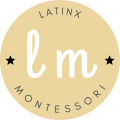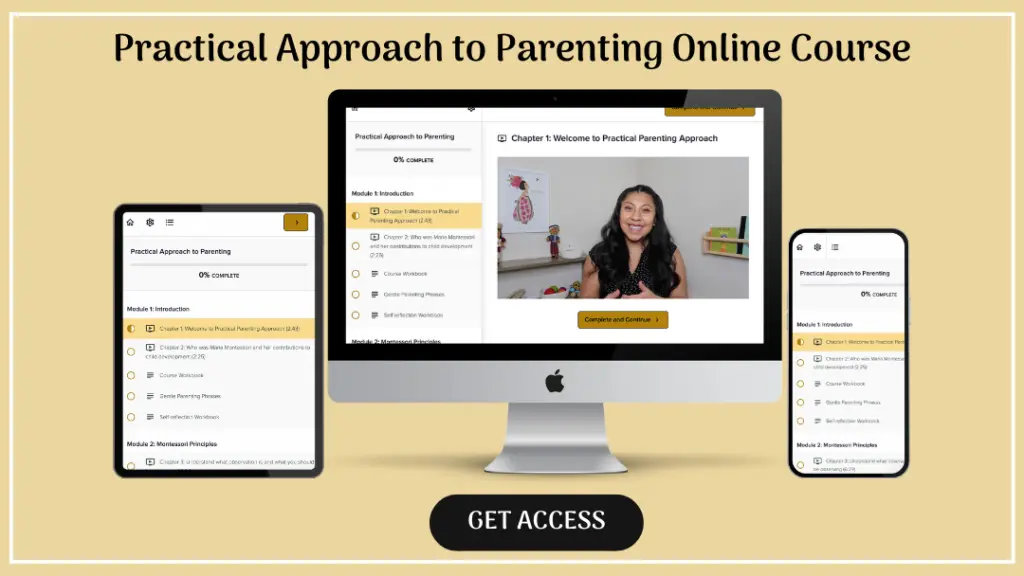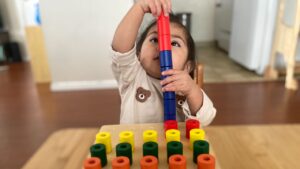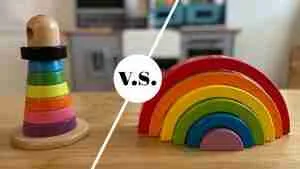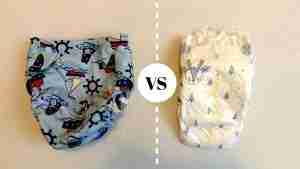
11 Effortless Ways to Create a Montessori Environment at Home
Find out how you can easily set up a Montessori home environment.
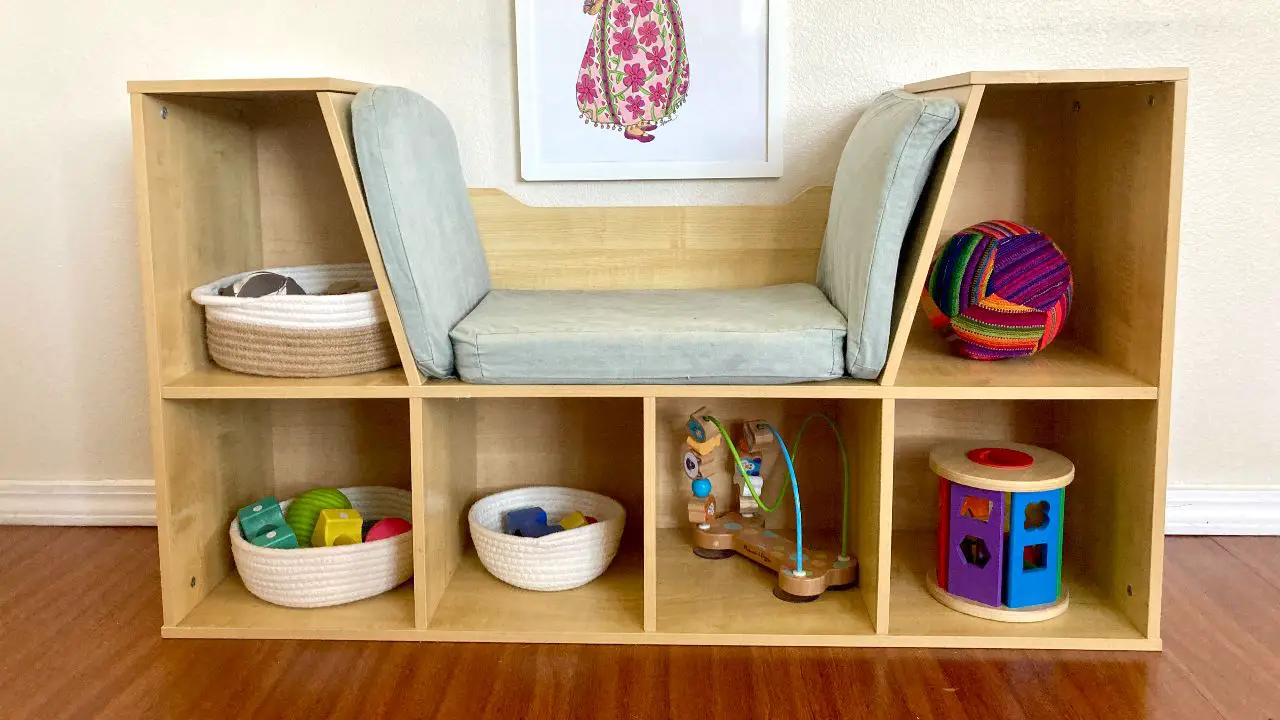
*Disclosure: I only recommend products I would use myself and all opinions expressed here are our own. This post may contain affiliate links that at no additional cost to you, I may earn a small commission. Thank you for your support!
As a parent, you want to create a safe, nurturing, and educational environment for your child at home. One approach to doing this is through the Montessori philosophy, which emphasizes the importance of independence, self-discovery, and hands-on learning.
In this article, we’ll explore the key elements of a Montessori-inspired home environment, including tips for setting up a Montessori bedroom, playroom, and outdoor play area, as well as advice for incorporating Montessori principles into daily routines and activities.
Whether you’re new to the Montessori philosophy or simply looking for new ways to support your child’s growth and development, this article will give you the tools and inspiration you need to create a Montessori-style home environment.
Benefits of a Montessori home environment
The Montessori philosophy is based on the principles of Dr. Maria Montessori and focuses on providing children with a prepared environment that encourages their natural curiosity and creativity.
By creating a Montessori environment at home, you can help your child develop important skills such as independence, concentration, and coordination. By the end of this article, you’ll have all the information you need to create a Montessori environment that your child will love.
Here are 11 strategies you can implement today to set up your Montessori home environment. You can also watch the video below!
1. Understanding the Montessori Philosophy
Before you start setting up your Montessori environment at home, it’s important to understand the basic principles of the Montessori philosophy. This will help you make sure you’re creating an environment that truly reflects the Montessori approach.
Some key principles of the Montessori philosophy include:
- Respecting each child as an individual.
- Providing a prepared environment that meets the child’s needs and interests.
- Encouraging independence and self-directed learning.
- Allowing children to learn at their own pace.
By keeping these principles in mind as you create your Montessori environment at home, you’ll be able to provide your child with a space that truly supports their learning and development.
2. Setting Up the Right Space
One of the most important aspects of creating a Montessori environment at home is setting up the right space. This includes both the physical space and the layout of the materials.
Here are a few things to keep in mind when setting up your Montessori home environment:
- Make sure the space is accessible to your child. All materials should be within reach, so your child can easily access them on their own. I recommend using low shelves where your child can easily access toys and materials.
- Ensure the space is well-lit. Natural light is ideal, but if you need to use artificial light, make sure it’s bright enough for your child to see clearly.
- Provide plenty of storage. Montessori materials should be easily accessible and organized, so your child can find what they need quickly and easily. I recommend using woven baskets because they are lightweight and easy to store.
3. Choosing the right furniture and materials
Another important aspect of creating a Montessori environment at home is choosing the right Montessori furniture and materials.
The arrangement of furniture and materials in a Montessori environment is intentional and carefully thought out. Furniture is designed to be functional and accessible to children, and materials are carefully selected and organized to support their development.
Parents can create a Montessori environment at home by arranging furniture and materials in a way that allows their child to easily access what they need.
For example, a low shelf or Montessori table can be used to store materials within reach, and a comfortable chair can be provided for reading and relaxation.
When selecting materials, keep in mind that Montessori materials should:
- Be age-appropriate.
- Encourage exploration and discovery.
- Be aesthetically pleasing.
- Be durable and long-lasting.
- Provide opportunities for hands-on learning.
4. Creating a Daily Routine
Having a daily routine is another important aspect of creating a Montessori environment at home. A routine can include simple activities such as meal times, rest times, and play times. This helps children develop a sense of time and order, which is essential for their overall well-being.
When creating your daily routine, consider your child’s individual needs and interests. For example, if your child is an early riser, you may want to have work time in the morning. On the other hand, if your child is a late bloomer, you may want to have work time in the afternoon.
It’s also important to be flexible and adjust your routine as needed. Children’s needs and interests can change, so be prepared to adapt your routine to best support your child’s development.
5. The right Montessori home set up will encourage independence
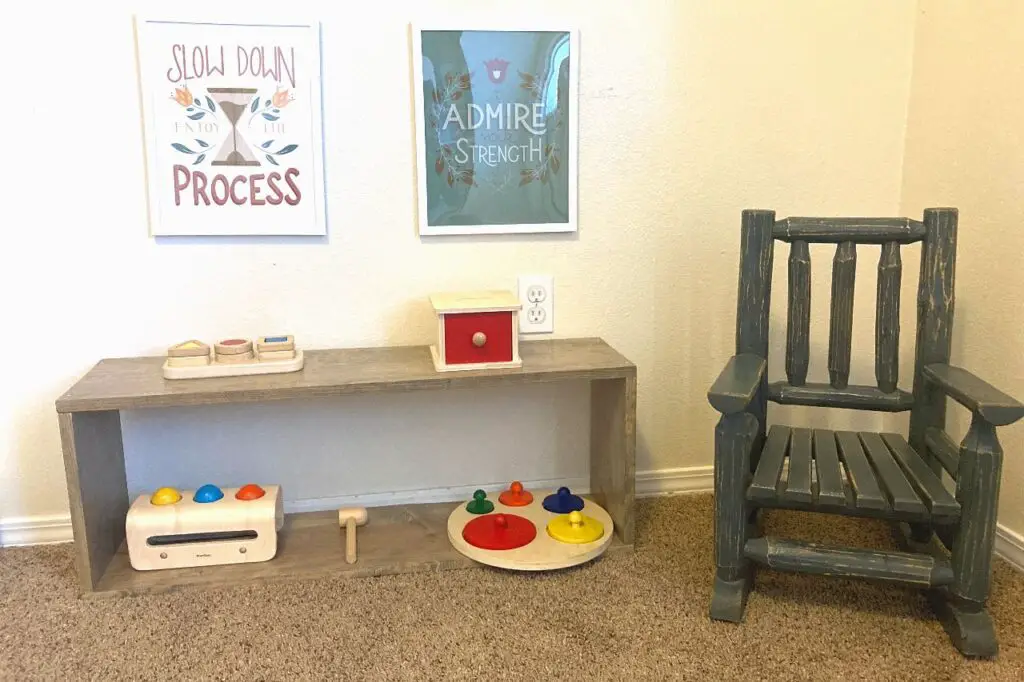
One of the key principles of the Montessori philosophy is encouraging independence in children. This means allowing them to make their own choices, take care of their own needs, and engage in self-directed learning.
To encourage independence in your Montessori home environment for your infant or toddler, consider providing:
- Clear and simple instructions for each activity.
- Opportunities for your child to take care of their own needs, such as getting dressed or preparing a snack.
- Independent work time, where your child can choose what they want to work on and at their own pace.
6. Fostering concentration and focus
Another important aspect of the Montessori environment for babies is fostering concentration and focus. This can help children develop their attention span and ability to complete tasks.
To encourage concentration and focus in your Montessori environment at home, consider the following:
- Providing simple and engaging activities.
- Allowing for independent work time, where your child can focus on a task without distractions.
- Avoiding overstimulation, such as excessive noise or too many activities at once.
I recently wrote an article on activities to encourage independent play. I highly encourage you to read this article.
7. Developing Coordination and Fine Motor Skills
The Montessori environment also focuses on developing coordination and fine motor skills. This includes activities such as pouring, spooning, and manipulating small objects.
If you have an infant or toddler, there are many simple activities you can do to help your child improve these areas of development. Check out my article on sensory play activities for infants and toddlers.
To encourage coordination and fine motor skill development in your Montessori environment at home, consider providing:
- Hands-on activities that involve manipulating small objects.
- Opportunities for your child to practice pouring, spooning, and other similar activities.
- Materials that are the right size and weight for your child’s age and ability.
- Materials with different textures.
8. Creating a Sensory-Rich Environment through Color, Texture, and Materials
A Montessori environment is designed to stimulate the senses and encourage exploration. This can be achieved through the use of bright, bold colors, textured materials, and a variety of objects and materials.
Parents can create a sensory-rich environment in their home by incorporating a variety of materials and textures, such as soft blankets, wooden blocks, and textured fabrics.
They can also use color to create a warm and inviting atmosphere, such as using warm reds and yellows to create a cozy atmosphere, or cool blues and greens to create a calming space.
To encourage sensory exploration in your Montessori environment at home, consider:
- Providing materials that stimulate the different senses, such as textured materials or fragrant plants.
- Encouraging your child to explore the natural world, such as going on nature walks or playing in the backyard.
- Providing opportunities for your child to experiment with different textures, such as playdough or sand.
9. Supporting Language and Communication Development
The Montessori environment also focuses on supporting language and communication development in children. This includes activities that encourage speaking, listening, and understanding.
To support language and communication development in your Montessori environment at home, you can implement the following in your Montessori home setup:
- Providing opportunities for your child to practice speaking and listening, such as singing songs or having conversations.
- Encouraging your child to read and listen to stories.
- Providing materials that support language development, such as books or communication boards.
10. Creating a Community of Learners
Creating a community of learners is an important aspect of the Montessori environment. This means involving your child in activities with other children and fostering a sense of community.
To create a community of learners in your Montessori environment at home for your baby, consider the following:
- Organizing playdates with other children.
- Encouraging your child to participate in group activities, such as building projects or cooking together.
- Creating opportunities for your child to learn and work with other children, such as group work time or cooperative games.
11. Use Natural Materials and Objects in your Montessori home environment
The Montessori philosophy places a strong emphasis on the use of natural materials and objects, such as wood, stone, and glass. These materials are not only aesthetically pleasing, but they also provide a sense of grounding and stability.
Parents can create a Montessori environment at home by incorporating natural materials and objects, such as wooden toys and furniture, and incorporating live plants into the space. This not only creates a beautiful and calming atmosphere but also helps children connect with the natural world.
Montessori environment ay home FAQs
Is the Montessori philosophy only for young children?
No, the Montessori philosophy can be applied to children of all ages, from infancy to adulthood. While it is commonly associated with early childhood education, many schools and programs continue to apply the Montessori principles to older children and even adults.
Can I use Montessori materials at home?
Yes, you can use Montessori materials at home. There are many Montessori-inspired toys, games, and activities available for purchase, or you can make your own materials using household items.
Some Montessori materials and items I recommend include the Lovevery Play Gym, Pikler Triangle, small shelf, standup bar, and bookshelf. These are the Montessori materials that will be in our daughter’s room for years. Read more on setting up a Montessori bedroom for your infant or toddler.
How can I incorporate Montessori principles into our daily routine?
You can incorporate Montessori principles into your daily routine by creating a prepared environment that supports your child’s development, encouraging independence, fostering concentration and focus, and providing hands-on learning experiences. It’s also important to be flexible and adapt your routine as your child’s needs and interests change.
What are some benefits of the Montessori philosophy for children?
The Montessori philosophy can have many benefits for children, including promoting independence, encouraging concentration and focus, developing coordination and fine motor skills, fostering sensory exploration, supporting language and communication development, and creating a community of learners.
Final thoughts on creating a Montessori environment at home for your child
Creating a Montessori home environment can be a rewarding and fulfilling experience for both the parents and the child. By implementing the principles of the Montessori philosophy, parents can provide their child with an environment that fosters independence, creativity, and a love of learning.
By encouraging their child to explore, discover, and learn at their own pace, parents can help their child reach their full potential.
However, it’s important to remember that a Montessori environment at home is not about having all the materials and furniture in place, but about creating a space that is respectful, supportive, and responsive to the needs of the child.
So, if you’re looking to create a Montessori environment for your child at home, start with what you have and gradually add materials and activities as you go along. Most importantly, have fun, enjoy the journey, and watch your child blossom in their new Montessori environment!

Hello, I am Leslie. I am on a mission to help you support the growth and development of your child. With the right tools and proper guidance, you can navigate parenthood with confidence and assertion! My goal is to equip you with knowledge to help you construct a strong foundation for your child’s life.
Suggested articles
You May Also Like

7 Best Stroller Alternatives For All Occasions
We researched and tested various stroller alternatives to bring you a comprehensive list of options that are compact, lightweight, and excellent when you are on the go.
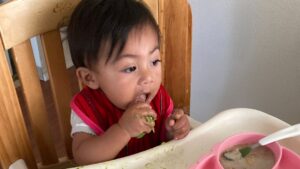
Best products for baby led weaning to start solids in 2023
Some must-have baby led weaning products include a high chair, bibs, plates, bowls, cups, and silverware that are designed to cater to your baby’s needs and make the baby led weaning process fun and easy.
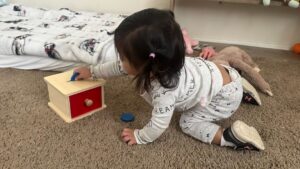
Surprising Benefits Of The Object Permanence Box
The object permanence box offers a simple yet effective way to enhance your child’s understanding of object permanence, hand-eye coordination, and motor skills.
